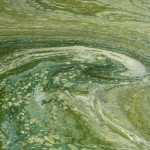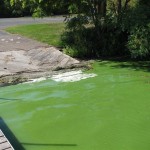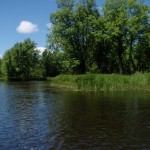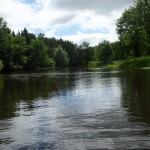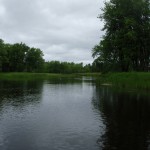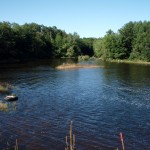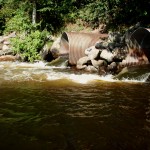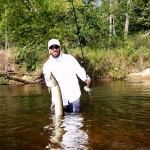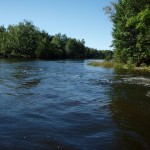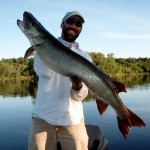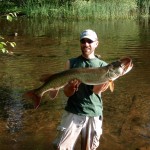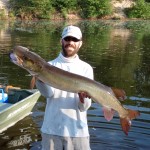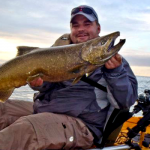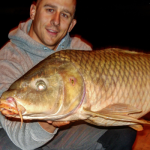By Adam M. Glickman
The dog days of summer just aren’t what they used to be. What used to be a week or two of bloomed out hot water in August has turned into lakes that are often 80 plus degree tubs of goo for 2-3 months at a time. Summers do seem a little warmer than they used to be, but he real culprit is nutrient pollution mostly in the form of phosphorus runoff from farms, yards, and golf courses. Algae thrives due to the increased fertility and lakes turn green early. The murky water absorbs much more of the sun’s energy and warms at an increased rate. The warmer water supports even more algae growth and the problem compounds. The hot water is not capable of containing good amounts of dissolved oxygen, the water stagnates, game fish lie low, and action turns lousy. Even if muskies were biting well, safe effective catch and release becomes tricky at best.
Summer musky activity peaks at 70-74 F, and good action can be had up to 76 F. Any warmer than that, and I notice a serious decline in activity. I live west of Minneapolis and all of my local lakes I consider pretty much unfishable for 1-3 months during all but the coolest of summers. I refuse to fish muskies in 78-86 F water, especially when the water is the color and consistency of pea soup. I have literally motored through pockets of algae bloom so thick that they have slowed my boat down. I cannot justify fishing muskies under such conditions because it is neither fun nor ethical. However, this does not mean that I don’t fish muskies during these times. I find conditions that are conducive to good action and proper catch and release. By that, I mean finding cooler water.
Deep Muskies
Most natural lakes and many reservoirs stratify during summer, which means they separate into a lower, middle, and upper layer. The middle layer is the thermocline. Below the thermocline is a cooler usually oxygen deficient layer. Above the thermocline is a warmer layer that is usually at least oxygen sufficient. During hot summers, many fish would like to drop below the thermocline to satisfy their physical temperature needs, but their bodies would not tolerate the lack of oxygen. However, the upper layer while warmer is not of uniform temperature. The upper layer is usually 18-26′ thick. At the surface it may be 84 F, but just above the thermocline it might be only 72-74 F which is perfect for peak musk activity. Fish Hawk makes excellent products for taking temperature at various depths. A cheaper solution I use is finding the thermocline on my graph, tying a few fish tank thermometers to a bell sinker, lowering them to just above the thermocline, leaving them in that zone for a minute or two, then pulling them up very quick to take a reading before they change too much. It sounds a little ghetto, it is a little ghetto, but it works in a pinch.
Most fish in any system will be looking for this cooler yet still oxygen sufficient water. If available forage uses open water and does not relate to structure (ciscoes for example), the forage will be over the main lake basin at the magic depth. If available forage is the type that uses structure (yellow perch or white suckers for example), the forage will be using structure at the magic depth. Muskies will be where they are most comfortable and have food. Find that combination, and it is only a matter of putting in time. Any presentations that put a lure into the right depth and keep it there will be the most effective. Trolling cranks, jigging Red October Tubes or Bondy Baits, and casting and counting down any lure that sinks are all tactics I would bank on to produce.
Seiche Tides
Seiche tides are a phenomenon that, among other things, draws cooler water from the depths into the shallows. Seiche tides occur when prolonged strong winds persist for a day or more from any one direction. They push most of the warm surface water to the downwind end of the lake, forcing cooler water to well up from the depths on the upwind end to replace what has left. Weed edges or any other form of cover on the upwind end of the water body that are right next to deeper water can all of a sudden drop 10 F when all of this falls into place. Muskies often take advantage of the opportunity to use shallower cover, and action can be tremendous though fleeting and tricky to time.
Cold Fronts
Cold fronts, while detrimental during the early part of the season when warming water is desired, are great during the heat of summer. Cloudy, cool, windy, rainy weather can quickly cool certain types of water or certain areas of a water body to the point that a massive feeding trend is triggered from muskies that had been lying low. Lakes that are deep and mostly contained in one large basin are usually effected very little by a change in weather. The same is true of large deep rivers. Smaller, shallower lakes can be a gold mine though. A cold wind ripping across a weedy flat or into the weed edge at the mouth of a bay cools the water quickly, as the cool air is literally folded into the water by the wave action. With no direct sunlight to warm the water, this process occurs quickly. Cold rain on top of all this also hastens the decline in temperature. As the water temperature drops from the neighborhood of 80 F closer to the area of 70 F, muskies often become very active. Sadly, severe weather (heavy electrical activity) will most often put the fish down regardless of what the water temperature is doing.
Small and Medium Rivers
Small and medium rivers are especially prone to cooling rapidly during cold fronts, or any time the blistering sun isn’t pounding down on them. All it really takes is a cloudy warm day or just an overnight period to get a significant drop in temperature. Put the two together, and some of my favorite rivers will drop 10-12 F in a 24 hour period. They will drop 12-16 F during a cold front. These rivers either have long uninterrupted stretches (no dams for at least 15-20 miles) or lots or cool ground water influx or both.
Dams on rivers create man made lakes which build up more warmth and hold on to that warmth more than the free flowing river would. Most dams in the upper Midwest have a spillway over which the surface water from the reservoir falls, and as such the river below has a constant warm water influx during the summer. The more dams a river has the warmer its water will be. It is usually the case that water clarity decreases and water temperature increases during the downstream progression on a river. However, if a river is getting warm murky water coming over a dam, but it gets a lot of clear cool water influx along its downstream course, water quality will improve downstream. Hitting these waters when the time is right and/or in the right areas can yield tremendous results.
Cool Water Inlets
Cool water inlets are great places to target muskies during the heat of summer on rivers as well as lakes provided the area can concentrate the cooler water and there is some type of cover. Cool water inlets will attract muskies when the rest of the water is excessively warm if the cool water can collect in a decent enough volume for the muskies to hold in. A trickle of cold water entering the main stream of a large river isn’t going to cut it. However, a good size trout stream entering a swift small to medium river will create a good seam and pocket of cold water along the bank due to thermal separation. Principals of thermal separation state that water masses of two different temperatures will resist mixing for at least a little while. This strip of cool water created by the inlet will only hold muskies if it enters into a deeper cut or creates a hole on its own. If it enters an area that is 200 yards of sand and 6″ of water, the chances of it attracting fish are slim to none.
Cool water inlets that enter lakes have a much better chance of creating cool water pockets, even if they are low volume. A wind pounding into the inlet further keeps the cool water from dissipating into the lake. With time and money, it would be nice to go around and stick a thermometer into every tributary creek during the dead of summer. In lieu of that, fishing regulation booklets help tremendously. If a stream is regulated for a trout fishery, it almost certainly has cool water. A solid game plan can be constructed in one’s spare time at home with no additional expense.
Dams in the upper Midwest usually draw water from the upper warm water layer of the reservoir, or the reservoir is so shallow and currented that it is all the same temperature and it doesn’t matter where the dam draws from. The dams on southern reservoirs are almost all cold water draws, which means they mostly or completely draw water from the cool depths of the lake above. If a water body and dam like this can be found in the north country, even if the discharge is only as cool as the low to mid 70’s F when everything else is 80 F, it will draw muskies if they are anywhere near.
Stay Cool
These options will produce muskies in the dead of summer. They are certainly no El Dorado or miracle cure, but they will work if time and money are invested in them. One word of caution, if the muskies strike, fight, and are landed in cooler water; they are not likely to stress. Just lift them briefly for a picture, especially if the air is very warm. However, if the muskies strike in cool water and are pulled into a warmer water zone for fighting and landing; they may very well stress if extreme caution is not taken. If they must be photographed, only pull them from the water for 5-10 seconds. Dropping the net from around them and never removing them from the water is best. Protect our shared resources, don’t get heat stroke, and have fun this summer.
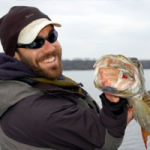 Adam M. Glickman
Adam M. Glickman
Adam Glickman, 33, originally from Ashland Wisconsin but now of the Minnesota Metro area, is field editor with Muskie Magazine, and a frequent contributor to Fishing-Headquarters and the online magazine. In 2014, Glickman began producing his new fishing program: Honest Musky Television is a unique, educational and entertaining fishing show. Our techniques are diverse, versatile, and often cost effective. We always get the strike and hookset on film, and in true honest musky fashion we use no fake hook sets or editing tricks. Glickman and his team films on a vast variety of aquatic environments from the smallest streams to the largest lakes, and done exclusively on public water, mostly in the Upper Midwest at affordable and realistic destinations.




